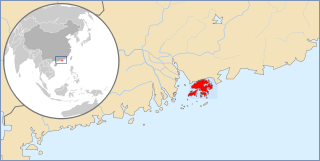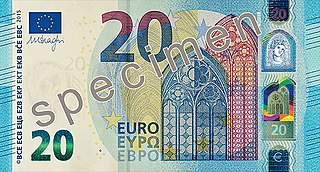
A banknote or bank note – also called a bill or simply a note – is a type of paper money that is made and distributed ("issued") by a bank of issue, payable to the bearer on demand. Banknotes were originally issued by commercial banks, which were legally required to redeem the notes for legal tender when presented to the chief cashier of the originating bank. These commercial banknotes only traded at face value in the market served by the issuing bank. Commercial banknotes have primarily been replaced by national banknotes issued by central banks or monetary authorities.

Banknotes of the Philippine peso are issued by the Bangko Sentral ng Pilipinas for circulation in the Philippines. The smallest amount of legal tender in wide circulation is ₱20 and the largest is ₱1000. The front side of each banknote features prominent people along with buildings, and events in the country's history while the reverse side depicts landmarks and animals.

Security printing is the field of the printing industry that deals with the printing of items such as banknotes, cheques, passports, tamper-evident labels, security tapes, product authentication, stock certificates, postage stamps, and identity cards. The main goal of security printing is to prevent forgery, tampering, or counterfeiting. More recently many of the techniques used to protect these high-value documents have become more available to commercial printers, whether they are using the more traditional offset and flexographic presses or the newer digital platforms. Businesses are protecting their lesser-value documents such as transcripts, coupons and prescription pads by incorporating some of the features listed below to ensure that they cannot be forged or that alteration of the data cannot occur undetected.

The Canadian fifty-dollar note is one of the most common banknotes of the Canadian dollar. It is sometimes dispensed by ATMs but not as commonly as the $20 note.

The Canadian one-hundred-dollar note is one of five banknotes of the Canadian dollar. It is the highest-valued and least-circulated of the notes since the thousand-dollar note was gradually removed from circulation starting in 2000.

The Portrait Series of currency notes is the fourth and current set of notes to be issued for circulation in Singapore. It was first introduced on 9 September 1999 by the Board of Commissioners of Currency, Singapore (BCCS), whose role was since taken over by the Monetary Authority of Singapore (MAS) post-merger.

Counterfeit money is currency produced outside of the legal sanction of a state or government, usually in a deliberate attempt to imitate that currency and so as to deceive its recipient. Producing or using counterfeit money is a form of fraud or forgery, and is illegal in all jurisdictions of the world. The business of counterfeiting money is nearly as old as money itself: plated copies have been found of Lydian coins, which are thought to be among the first Western coins. Before the introduction of paper money, the most prevalent method of counterfeiting involved mixing base metals with pure gold or silver. Another form of counterfeiting is the production of documents by legitimate printers in response to fraudulent instructions. During World War II, the Nazis forged British pounds and American dollars. Today, some of the finest counterfeit banknotes are called Superdollars because of their high quality and imitation of the real US dollar. There has been significant counterfeiting of Euro banknotes and coins since the launch of the currency in 2002, but considerably less than that of the US dollar.

The issue of banknotes of the Hong Kong dollar is governed in the Special Administrative Region of Hong Kong by the Hong Kong Monetary Authority (HKMA), the governmental currency board and central bank of Hong Kong. Under licence from the HKMA, three commercial banks issue their own banknotes for general circulation in the region. Notes are also issued by the HKMA itself.

The Moroccan dirham is the official monetary currency of Morocco. It is issued by the Bank Al-Maghrib, the central bank of Morocco. One Moroccan dirham is subdivided into 100 santimat.
The notes of the Australian dollar were first issued by the Reserve Bank of Australia on 14 February 1966, when Australia changed to decimal currency and replaced the pound with the dollar. This currency was a lot easier for calculating compared to the previous Australian pound worth 20 shillings or 240 pence.
Since 1867 there have been four successive currencies in Romania known as the leu. This article details the banknotes denominated in the leu and its subdivision the ban since 1917, with images.
New Zealand dollar banknotes are the banknotes in circulation in New Zealand, the Cook Islands, Tokelau, Niue and the Pitcairn Islands, denominated in the New Zealand dollar. They are issued by the Reserve Bank of New Zealand and since 1999 have been made of polymer.

Banknotes of the euro, the common currency of the eurozone, have been in circulation since the first series was issued in 2002. They are issued by the national central banks of the Eurosystem or the European Central Bank. The euro was established in 1999, but "for the first three years it was an invisible currency, used for accounting purposes only, e.g. in electronic payments". In 2002, notes and coins began to circulate. The euro rapidly took over from the former national currencies and slowly expanded around the European Union.

The twenty euro note (€20) is the third-lowest value euro banknote and has been used since the introduction of the euro in 2002. The note is used in the 25 countries that have it as their sole currency, which countries have a total population of about 350 million currently. In July 2024, there were approximately 4,818,000,000 twenty euro banknotes in circulation around the eurozone. It is the second most widely circulated denomination, accounting for 16.3% of the total banknotes. Estimates suggest that the average life of a twenty euro banknote is about two years before it is replaced due to wear.

The fifty euro note (€50) is one of the middle value euro banknotes and has been used since the introduction of the euro in 2002. The note is used in the 25 countries that have it as their sole currency, which countries have a total population of about 350 million currently. In July 2024, there were about 14,712,000,000 fifty euro banknotes in circulation in the eurozone. It is by far the most widely circulated denomination, accounting for almost half (49.0%) of the total banknotes. Estimates suggest that the average life of a fifty euro banknote is about four years before it is replaced due to wear.

The New Zealand ten-dollar note is a New Zealand banknote. It is issued by the Reserve Bank of New Zealand and since 1999 has been a polymer banknote. It was first issued on 10 July 1967 when New Zealand decimalised its currency, changing from the New Zealand pound to the New Zealand dollar. The ten-dollar note originally had an image of Queen Elizabeth II on the front; since 1991 it has had an image of suffragist Kate Sheppard.

The Frontier series is the seventh series of banknotes of the Canadian dollar released by the Bank of Canada, first circulated in 2011. The polymer banknotes were designed for increased durability and to incorporate more security features over the preceding 2001 Canadian Journey series. The notes feature images that focus on historic Canadian achievements and innovation. Printed on polymer, the 2011 Frontier series was the first series issued by the Bank of Canada printed on a material other than paper. The 2011 Frontier series is being followed by the Vertical series.
The Mexican 20-peso note is the smallest denomination in circulation of Mexican currency, and is the most commonly used in Mexico, other than the 1,000-peso note that is normally only used for high-value transactions. On august 27, 2018 it was confirmed there is a plan for the note to be gradually replaced by a coin.

The twenty new shekel note (₪20) is the lowest value banknote of the Israeli new shekel, It was first issued in Series A 1988, with the Series B in 1999, and Series C in 2017.
A diffractive optically variable image device (DOVID) is a type of optical variable device; a security feature based on visual effects created by diffraction. The acronym was coined by Ian Lancaster of Reconnaissance International in 1995. He pointed out that the security print industry was wary of holograms and similar diffractive devices because they were used as decorative, promotional and toy items, proposing the use of DOVID as a means to differentiate security diffractive optical devices from these other uses.






















